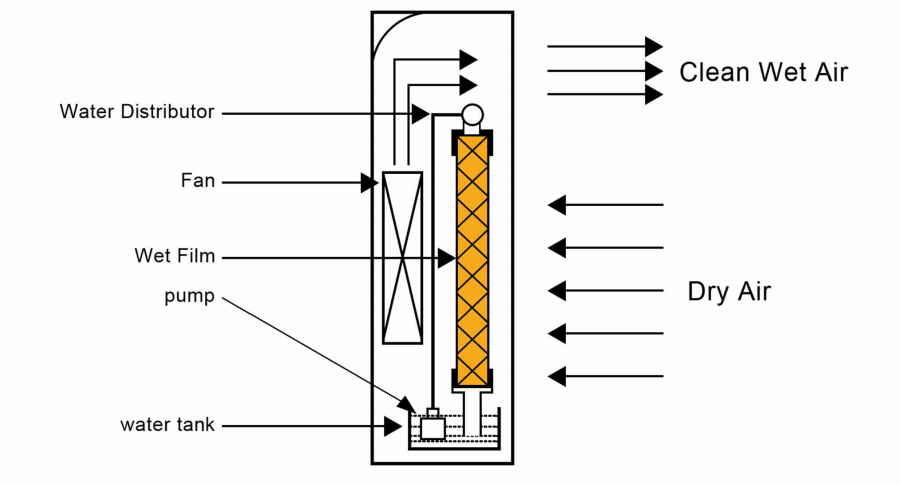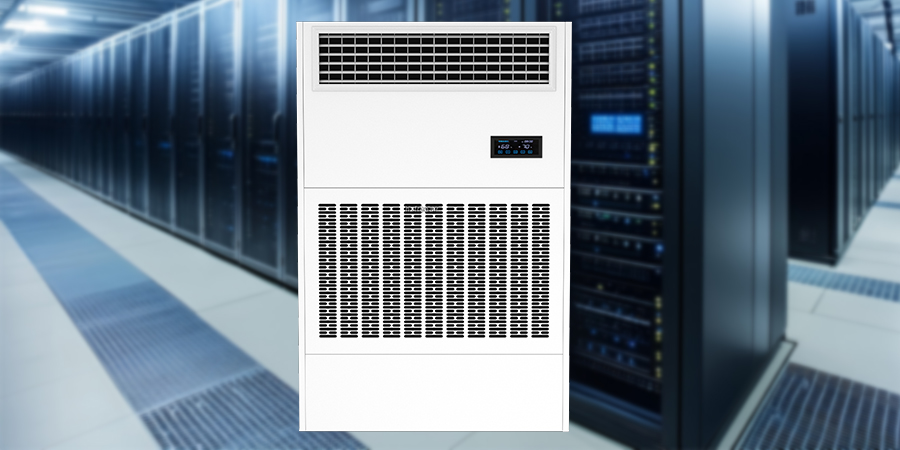


In modern industrial production, commercial environments, and household life, the wet film humidifier, with its unique humidification principle and
significant technical advantages, is becoming the preferred humidity regulation equipment for an increasing number of places. This article will
comprehensively introduce the working principle, core advantages, selection tips, and applicable scenarios of the wet film humidifier. In particular,
it will conduct in-depth analysis of the application needs in industrial workshops, helping readers understand this efficient and energy-saving
humidity control technology.
The working principle of the wet film humidifier
The wet film humidifier (also known as an evaporative humidifier) is an environmental control device based on the principle of isenthalpic humidification.
Its core working principle is to use a water pump to transfer water from the water tank to the water spray device at the top of the humidifier.
The water is evenly distributed on the surface of the wet film material to form a water film. When dry air passes through the humid wet film, some of the
water comes into contactwith the air and evaporates, increasing the humidity of the air; the unevaporated water then flows back to the water tank for recycling.
This natural evaporation process simulates the evaporation method of water in nature and is the closest to nature's humidification method.

The core advantages and application value of the wet film humidifier
Clean and healthy humidification method:
The wet film humidifier operates through a physical evaporation process, and does not have the "white powder" phenomenon commonly seen
in traditional ultrasonic humidifiers (white powder formed by the diffusion of minerals in water through water mist), avoiding secondary pollution.
At the same time, the high-quality wet film material contains antibacterial components, which can effectively inhibit the growth of bacteria and
ensure the hygiene and safety of the humidification process.
Intelligent and precise humidity control:
Modern wet film humidifiers are equipped with high-precision temperature and humidity sensors and automatic control systems. They can adjust
the humidification amount in real time according to environmental changes, and keep the humidity stable within the set range (usually with an accuracy of ±2%RH).
Some high-end models also support remote monitoring and intelligent linkage, meeting the management needs of modern intelligent factories.
Low maintenance cost:
The structure of the wet film humidifier is simple and maintenance is convenient. The wet film material is easy to clean or replace, and the waterway
system is designed reasonably, reducing the workload of daily maintenance. Compared with other types of humidification equipment, its comprehensive
maintenance cost can be reduced by more than 30%.
Analysis of the Applicable Scenarios of Wet Film Humidifiers
Application in Electronic Manufacturing Workshops:
In SMT (Surface Mount Technology) workshops, electrostatic protection is a key factor in ensuring product quality. The wet film humidifier maintains
the environmental humidity at an ideal range of 45%-60% RH, effectively preventing the accumulation of static electricity and reducing the damage
caused by electrostatic discharge (ESD) to precision electronic components.
Pharmaceutical and Medical Environment:
The pharmaceutical industry has strict requirements for humidity control in production environments. Low humidity can lead to problems such as
decomposition of drug active ingredients and deformation of packaging materials. The wet film humidifier, with its clean and pollution-free humidification
method, is particularly suitable for use in GMP clean workshops. Its antibacterial wet film material can avoid the risk of microbial contamination.
Medical places such as hospital operating rooms and sterile wards can also benefit from the stable humidity environment provided by the wet film
humidification technology.
Textile and Printing Industry:
Maintaining an appropriate humidity level in textile factories can reduce fiber breakage and static electricity-induced dust adsorption, thereby
improving product quality and production efficiency. Controlling humidity in printing workshops can prevent paper deformation and ensure printing accuracy.
The large humidification capacity and uniform distribution characteristics of wet film humidifiers can meet the special requirements of these industries for
humidity control in large areas.
Agriculture and Storage Applications:
Agricultural facilities such as flower greenhouses and edible fungi cultivation require precise humidity control to optimize growth conditions.
Maintaining an appropriate humidity level in storage environments can prevent goods from cracking, deforming, or accumulating static electricity.
The stability and economy of wet film humidifiers make them highly applicable in these fields.

How to Choose the Right Humidifier with Wet Film
Matching Humidifying Capacity:
This is the primary consideration when choosing a wet film humidifier. Users need to calculate the theoretical humidifying volume (usually in kg/h)
based on the volume of the application space, the initial humidity level, and the target humidity requirement.
Industrial workshops generally require a machine with a humidifying capacity of 3-15 kilograms per hour, while commercial spaces may opt for smaller
models with 1-5 kg/h. It is worth noting that factors such as space sealing, personnel density, and ventilation conditions should also be considered,
and a 20%-30% margin should be appropriately increased.
Quality of Wet Film Material:
The wet film is the core component, and its quality directly affects the humidifying efficiency and service life. High-quality wet films should have
high water absorption rate, good mechanical strength, and antibacterial properties.
Consumers can pay attention to parameters such as the patent technology of the material, the antibacterial treatment method, and the expected service life,
and prefer to choose products from well-known suppliers.
Control Precision and Intelligence:
Modern wet film humidifiers should have precise humidity sensing and control capabilities, with an error range of best within ±3%RH. For industrial users with
centralized monitoring requirements, intelligent models that support remote communication, data recording, and alarm functions can be selected,
making it convenient to integrate into the factory's building automation system.
Safety Protection Measures:
Reliable wet film humidifiers should have multiple safety protections, such as water shortage power-off, motor overheating protection, and leakage protection.
Equipment used in industrial environments also need to consider the dust-proof and waterproof rating (IP rating) to ensure adaptation to the workshop environment.
The wet film humidifier, as a mature and reliable humidity regulation technology, has proven its value in numerous fields. With the development of materials science
and intelligent control technology, modern wet film humidification equipment has continuously improved in terms of performance, energy efficiency, and intelligence,
providing users with more efficient and cost-effective humidity control solutions.
Whether it is for the static electricity protection in electronic factories or the improvement of comfort in commercial spaces, the wet film humidification technology can
play a unique role. When purchasing, users should comprehensively consider actual needs, product performance, and long-term usage costs, select the most suitable
equipment and suppliers, and fully utilize the advantages of this technology to create a healthier and more comfortable production and living environment.
